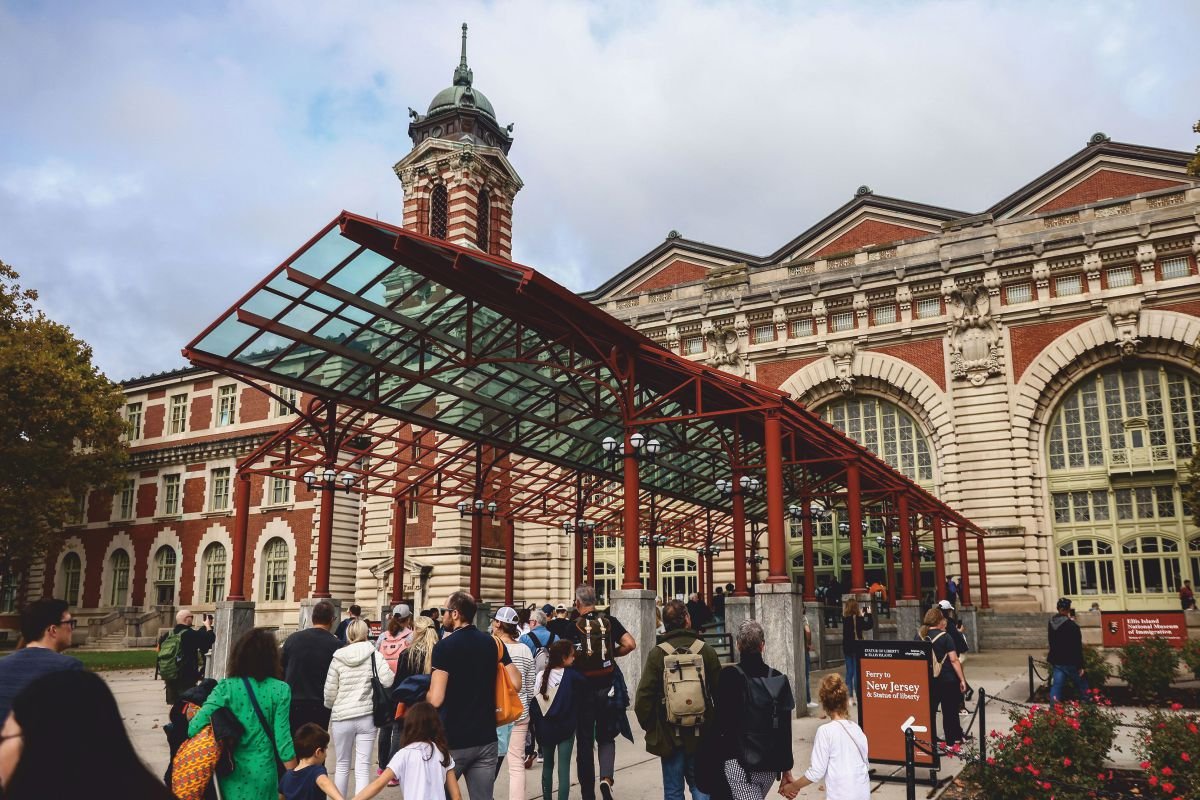In the early 20th century, a gateway stood at the edge of America, welcoming both hopeful and weary travelers. This gateway observed dreams being realized, lives being reconstructed, and new stories beginning. It was a place where languages intertwined, cultures came together, and the essence of America’s diverse population emerged. This historic site, filled with stories of ambition and determination, is known as Ellis Island. As a symbol of America’s immigrant history, this island signifies the experiences of millions who pursued a better life in this country, leaving a lasting impact on the nation’s identity. In this article, we will explore more things about this island.
The Historical Significance of Ellis Island
The Early Days
It has a rich history that dates back to its time as an immigration station. Originally called Kioshk, which means Gull Island, by the Native American Lenape tribe, it was later renamed Oyster Island by Dutch settlers because of its plentiful oyster beds. In the 1770s, the island was owned by Samuel Ellis, for whom it is named. The U.S. federal government acquired it in 1808 and used it mainly as a fort and storage for munitions during the War of 1812.
The transition of Ellis Island into an immigration center began in the late 19th century. The federal government needed a central location to handle the large number of immigrants arriving in the country. On January 1, 1892, it officially opened as an immigration station. The first immigrant processed there was Annie Moore, a 15-year-old girl from Ireland. Over the next six decades, millions of others followed her example, seeking a fresh start in America.
The Immigration Experience
For many immigrants, the journey to this island was difficult and filled with a mix of hope and fear. Most traveled in steerage, the cheapest and most crowded part of the ship. Conditions were often unsanitary, with limited food and fresh water. However, the promise of a better life in America kept their spirits up.

Upon arrival, immigrants were taken to Ellis Island for processing. The process varied in length, with some experiencing a quick process while others faced a more lengthy one. Immigrants underwent medical examinations and legal inspections. Those with health issues were further examined, and some were quarantined or deported. Legal inspections involved a series of questions to determine eligibility to enter the country. Despite the challenges, around 98% of immigrants were eventually allowed to enter the United States.
Life on Ellis Island was not easy. Immigrants endured long waiting periods, sometimes lasting weeks or months, before being permitted to leave. The island provided a hospital, dormitory, and dining facilities to accommodate those detained. Despite the difficulties, Ellis Island represented new beginnings for many. Passing through its gates marked the start of their American dream.
Ellis Island in Numbers
Between 1892 and 1954, Ellis Island processed over 12 million immigrants. The peak year was 1907 when over one million immigrants were processed. The majority came from Europe, with Italians, Russians, and Germans being the most common nationalities. Immigrants from other parts of the world, such as Asia and the Middle East, also arrived on the island.
While the majority of immigrants were admitted into the United States, a small percentage were detained and deported. Reasons for deportation included health issues, criminal backgrounds, or failure to pass legal inspections. However, despite the concerns of being sent back, the overall deportation rate was relatively low and most immigrants eventually gained entry into the country.
The Legacy of Ellis Island
Ellis Island immigrants made significant contributions to American society by bringing diverse cultures, languages, and traditions that enriched the American tapestry. Many immigrants settled in cities, contributing to the industrial workforce, while others moved westward and played crucial roles in the development of agriculture and infrastructure.

The role of this island began to decline in the early 20th century due to the Immigration Act of 1924, which imposed strict quotas and drastically reduced the number of immigrants. By 1954, the island was closed as an immigration station. However, its legacy as a symbol of hope and opportunity continues to endure.
Today, this island is part of the Statue of Liberty National Monument and houses the Ellis Island Immigration Museum, which opened in 1990 and attracts millions of visitors each year. The museum offers a wealth of information about the immigrant experience through exhibits, photographs, and personal stories. Visitors can also explore the American Family Immigration History Center, which provides access to ship manifests and other historical documents.
Personal Stories from Ellis Island
This island serves as more than just a historical site; it holds a collection of personal stories that showcase the resilience and determination of immigrants. One notable story is that of Fiorello La Guardia, who passed through Ellis Island as a child and eventually became the mayor of New York City. Another impactful tale is that of Golda Meir, who later became the Prime Minister of Israel.
Many Americans today can trace their ancestry back to Ellis Island. The island’s extensive records serve as a valuable resource for genealogical research. For many, uncovering their ancestors’ journey through Ellis Island is a significant and emotional experience that connects them to their heritage.
Visiting Ellis Island
Planning Your Visit:
Visiting this island is a journey into American history that can be accessed by ferry from Battery Park in New York City and Liberty State Park in New Jersey. A typical visit includes stops at both the Statue of Liberty and the Ellis Island Immigration Museum.
Museum Highlights:
The Ellis Island Immigration Museum offers a variety of exhibits that offer insight into the immigrant experience. Some key highlights include:
- The Great Hall: The main processing area where immigrants were first inspected.
- The American Immigrant Wall of Honor: A tribute to the millions of immigrants who passed through Ellis Island.
- Interactive Exhibits: These allow visitors to engage with personal stories and historical data.
- Family History Center: Here, visitors can search for their ancestors and explore ship manifests.
Educational Programs:
This island provides a variety of educational programs for schools and groups that offer a deeper understanding of the island’s history and its significance in American immigration. These programs include guided tours, workshops, and interactive activities that help visitors gain a comprehensive view of the immigrant experience.
The Cultural Impact of Ellis Island:
This island has been portrayed in literature and film as a symbol of the hopes and dreams of immigrants. Notable works such as “Ellis Island: Gateway to the American Dream” by Pamela Reeves and the film “The Immigrant” directed by James Gray depict the emotional and physical challenges faced by immigrants and celebrate their contributions to American society.
In the realm of art and music,this island has served as inspiration for numerous artists and musicians. The stories of immigrants have been depicted in paintings, sculptures, and songs, reflecting the profound cultural impact of the island. One example is the song “Isle of Hope, Isle of Tears” by Brendan Graham, which poignantly narrates the journey of Annie Moore to America.
This island also hosts a variety of events throughout the year that celebrate the diverse cultural heritage of immigrants. These events, including festivals, cultural performances, and heritage days, provide a platform for communities to honor their ancestors and share their traditions.
Preserving Ellis Island for Future Generations:

Restoration Efforts
Maintaining the historical integrity of Ellis Island is an ongoing effort. The island underwent a major restoration in the 1980s, led by the National Park Service and the Statue of Liberty-Ellis Island Foundation. This project focused on restoring the main immigration building and safeguarding numerous historical artifacts. Today, ongoing preservation work is being carried out to ensure that this island continues to serve as a vital link to America’s past.
Volunteer and Support Opportunities
Many organizations and volunteers contribute to the preservation and education efforts at Ellis Island. Opportunities for involvement include:
- Volunteering: Volunteers assist with educational programs, museum operations, and preservation projects.
- Donations: Contributions to the Statue of Liberty-Ellis Island Foundation support ongoing restoration and educational initiatives.
- Advocacy: Advocates work to raise awareness about the historical significance of Ellis Island and promote its preservation.
Future Plans
Looking ahead, plans for this island involve expanding its educational programs and enhancing visitor experiences. New exhibits and interactive displays are currently being developed with the goal of engaging younger audiences and ensuring that the legacy of Ellis Island remains relevant for future generations.
Conclusion
Ellis Island is a symbol of America’s immigrant heritage, representing the experiences of millions who sought a better life in the United States. As a site of historical importance, Ellis Island continues to inspire and educate, highlighting the impact of immigration on the American narrative. By preserving its history and sharing its stories, we honor the legacy of those who passed through its halls and acknowledge the diverse fabric of our nation.








